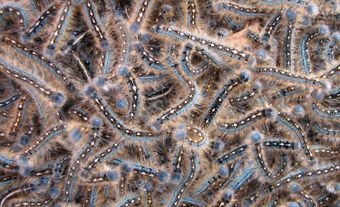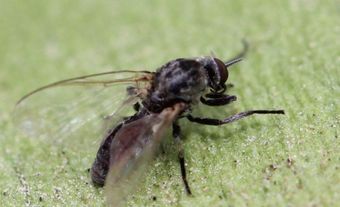Bedbugs (Cimex spp.) are small insects that feed on the blood of vertebrates. They cannot fly, jump or travel very far independently, so they primarily spread between locations by being carried on objects and clothing. Bedbugs are hemipterans, or “true bugs,” in the family Cimicidae. There are hundreds of bedbug species, with two species that are common pests of humans: Cimex hemipterus and, more commonly, C. lectularius. They have been a pest-control issue in Canada and the rest of the world since at least the early 2000s. Bedbugs have been parasites of humans for thousands of years and likely evolved from an ancestor that lived in caves and fed on bats.

Description
Bedbugs are small, wingless insects that cannot fly or jump. They are about the size and shape of a flax seed and can grow up to 7 mm in length. If they have not recently fed, adult bedbugs are brown with flat bodies. Recently fed individuals are reddish, and their abdomens become more elongated and rounded. Young bedbugs, known as nymphs, are smaller than adults, as well as pale and translucent before feeding. After feeding, they are bright red.
Distribution and Habitat
Bedbugs are found worldwide, wherever humans are present. They are especially widespread in places with large human populations. They can be found in homes, offices, public buildings and vehicles. Apartment buildings and hotels are particularly susceptible to repeated infestations.
Bedbugs prefer habitats with nearby feeding sources and plenty of hiding places. They commonly live in rooms where people sleep, hiding during the day in the cracks and crevices of furniture, mattresses, wallpaper, books, curtains, and electrical outlets. A single colony can consist of thousands of individuals.
Reproduction and Development
Bedbugs reproduce via hypodermic insemination. During this process, the male pierces the female's body cavity to release reproductive cells into an organ known as the mesospermagele, which directs the sperm to fertilize eggs.
The female may lay ~2–4 eggs per day and 200–500 eggs in her lifetime. The eggs are white, approximately one millimetre long, and very difficult to see. The nymphs usually hatch from the eggs in 4–17 days and feed as soon as food is available. Nymphs transition through five stages before becoming reproductive adults, shedding their exoskeleton and growing in size each time. The life cycle from egg to egg can take anywhere from 30 to 200 days, depending on temperature and food availability in the form of blood. Bedbugs typically live for approximately ten months, although they can survive up to two years if conditions are ideal.
Diet and bites
Bedbugs feed exclusively on blood and preferentially seek out human hosts, although they may bite other animals when available. They generally emerge at night to feed on sleeping humans, attracted to the warmth and carbon dioxide that humans emit.
Bedbugs bite using a long, straw-like proboscis to pierce the skin. Bedbug bites are not known to spread any diseases. Although bedbug bites do not usually require medical attention, they can still result in itchy red bumps that may be mistaken for mosquito bites. These bumps can occur anywhere on the body but are often found on skin that is exposed while sleeping, such as the face, neck, arms and legs. The bumps may appear in clusters since a single bedbug may bite multiple times in one night to get a complete blood meal.
However, a lack of visible bite marks does not always indicate an absence of bedbugs; depending on the person, the bites can take up to 14 days to cause a reaction, and some humans do not react at all. Bedbugs feed every 3–15 days and can survive up to a year without feeding.
Infestations
Bedbug infestations are a growing problem worldwide. Insects can easily travel on furniture, luggage, clothing, and people without being detected, dispersing between buildings and even between countries.
Prevention
Several steps can be taken to prevent the introduction of bedbugs into an area. When travelling, it is important to check rooms for signs of bedbugs in places like mattress seams and furniture corners. Other than the insects themselves, a key sign of infestation is the debris that appears in and around the bedbugs’ habitat, consisting of dark splotches of digested blood and the shed and discarded skins of growing nymphs. If bedbugs are detected, the front desk should be informed immediately, and alternate accommodation should be found, either a new room or a new location altogether.
Treatment
Even with thorough preventative measures, bedbugs can still be introduced to homes by accident. Treating a bedbug infestation can be difficult and expensive. After the detection of bedbugs, all bed linens should be immediately laundered at the hottest possible temperature. Furniture and the surrounding area should be vacuumed to reduce the number of bedbugs within the household, with extra care taken to ensure bedbugs do not remain within the vacuum itself. In most cases, a professional pest control service should be contacted since the entire building will likely need to be treated. Although both chemical and nonchemical treatment options are possible, chemical control can be difficult because bedbugs have become resistant to many commonly used pesticides. A combination of treatments is often required, including vacuuming, freezing, laundering, diatomaceous earth, chemicals and heat. Any treatments may need to be repeated multiple times to ensure the infestation will not return.

 Share on Facebook
Share on Facebook Share on X
Share on X Share by Email
Share by Email Share on Google Classroom
Share on Google Classroom




